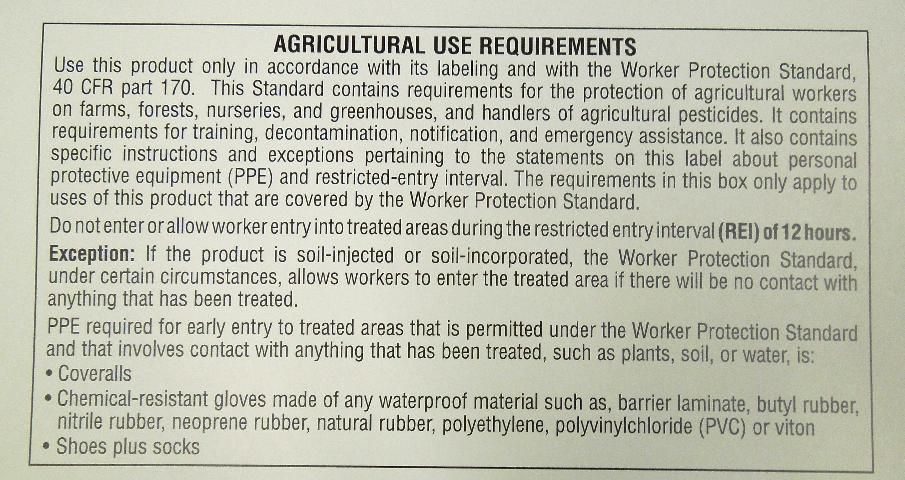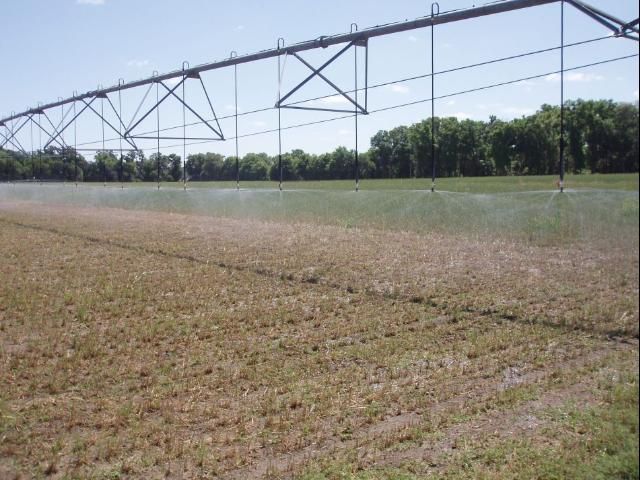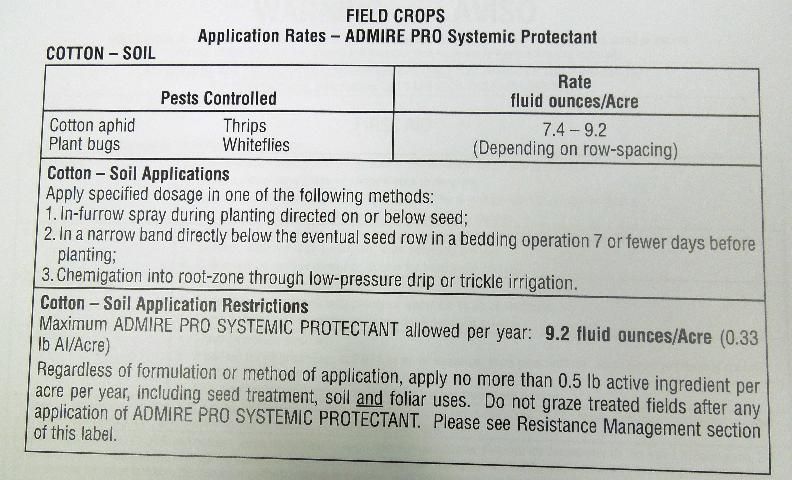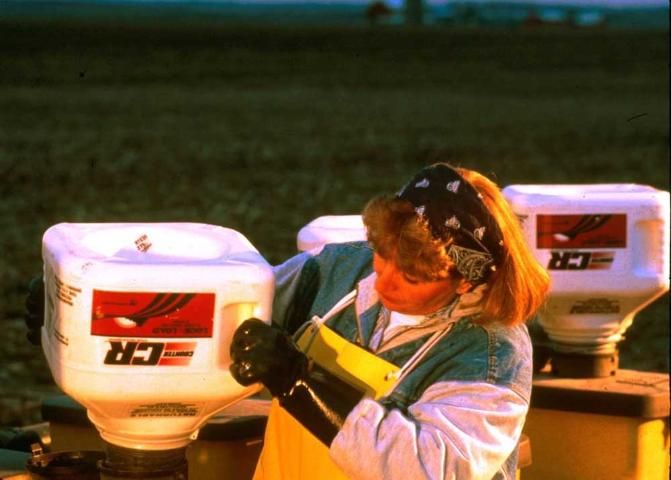This document describes the directions for use section of the pesticide label—usually the largest body of information found on most labels. Examples of typical directions for use statements are provided.
Introduction
It was the farm manager's worst nightmare. Upon inspecting a recently-treated field of peppers, the sight of severely-damaged pepper plants was unnerving. As he was walking out of the field, all he could think was, "What could have possibly happened to this crop?" Returning to the farm's main shop, the manager pulled a copy of the pesticide's label out of the file and carefully reviewed it. Then, after querying the employee who made the pesticide application about exactly what procedures were used in making the treatment, the answer quickly came to the manager. The pesticide was applied at the incorrect rate; in fact, at twice the rate suggested by the label. The employee explained that last season when he applied this same product, there was no injury. Why? The pesticide's manufacturer had doubled the amount of active ingredient contained in the product's new formulation in order to save money on the cost of shipping supplies of product to retail agrichemical dealers. If only the manager and employee had reviewed the content of the new label, most importantly the directions for use section, there would likely have been no crop injury. Besides unacceptable crop injury (Figure 1) or death, illegal residues can be created, and such misuses are subject to regulatory action because of off-label use. Fortunately, these are not common mistakes; but on occasion, they occur, sometimes with dramatic effects.

Purpose of Directions For Use
The directions for use of a pesticide label describe how the product may legally be used and how the product must not be used. Generally speaking, the necessary information includes:
• The pest(s) that the product may be used to control.
-
The sites where the product may be used.
-
The application methods that are required or preferred.
-
How much pesticide should be applied and the rate of application.
-
Whether there are any restrictions on use for factors such as weather, time of day, season of the year, contamination of sensitive areas, exposure of nontarget species, etc.
-
The application methods that are prohibited.
-
How often the pesticide should or may be applied.
-
All restricted entry intervals (REIs) pertaining to existing uses, as applicable.
-
Maximum application rates per treatment and per year.
-
Preharvest intervals (PHIs).
-
Storage and disposal.
-
Any other requirements as necessary.
The directions for use (Figure 2) reflect EPA's determination that the use of the product in such a manner does not cause unreasonable adverse effects on the environment or human health under FIFRA. The directions for use are organized and carefully worded so that the directions are understood by the person expected to use or to supervise the use of the pesticide. The sentences in the directions for use indicate whether any actions mentioned are required, prohibited, encouraged, or discouraged when using the product. Other sentences in the use directions may only convey background information.
Charts, tables, and graphics may be seen in many labels' directions for use and provide accurate information in a clear, concise, and complete manner. For example, an instructional statement such as this may be seen: "To make spray solution, mix 1 to 2 pints of this product in 100 gallons of water. Apply 100 to 200 gallons of diluted spray solution per acre to trees depending on tree size and the coverage obtained with the spray equipment used." Labels for agricultural products usually express the application rate in terms of pints/acre for liquid formulations, or pounds/acre for solid formulations. The directions for use for an agricultural pesticide used in a spray solution also must include the spray volume/unit area or other measurement of coverage, depending on the type of formulation. Labels for residential/household use products express the application rate in smaller units, such as ounces, teaspoons/gallon, or pounds/square foot. Such rates and units of measure are more appropriate for the home garden or yard.

Misuse Statement
All registered pesticides, including all end-use and manufacturing-use products, will bear labeling which has the following statement immediately below the Use Classification: "It is a violation of federal law to use this product in a manner inconsistent with its labeling." Other statements related to misuse may be seen on residential/household use products in addition to the previous general misuse statement:
-
"STOP!—Read the label before using."
-
"Use only as directed on this label."
-
"Read label very carefully, including any special requirements which pertain to your growing area."
-
"Failure to follow all precautions and directions is illegal."
Agricultural Use Requirements
The Worker Protection Standard (WPS) regulations require certain statements on the labeling of all pesticide products within the scope of the WPS (Figure 3). The WPS statements will appear after the general misuse statement under the heading "Agricultural Use Requirements (40 CFR 156.206)." WPS statements include information pertaining to Restricted Entry Intervals (REIs), notification to workers, and non-agricultural use requirements.

Chemigation Information
If products are not approved for application through irrigation systems (Figure 4), the label will state, "Do not apply this product through any type of irrigation system." Any product used on agricultural sites that may be applied by chemigation will contain the following information:
• Types of irrigation systems to be used.
-
Consequences of improper chemigation.
-
To whom questions about chemigation can be directed.
-
Warnings against connecting irrigation equipment to public water supplies without safety mechanisms.
-
Personnel required for adjustment of chemigation equipment.

Pests Controlled
Some labels often make pest claims on their front panel (Figure 5). For example, if the front panel lists fire ants as a target pest, then the directions for use must include the appropriate treatment directions for fire ants. This consistency is required by the EPA to prevent a registrant from misbranding their product. Some labels will very generally name target pests in their directions for use (e.g., ants); other labels may identify them specifically (e.g., carpenter ants). The pests listed on the label are appropriate for the intended use sites for the product. For example, pests listed on the labels of residential/household products should be typical household/garden pests. An agricultural crop specific pest, such as the cotton bollworm, would not be an appropriate pest claim for the label of a product intended only for use around the home.

Sites
The application or treatment site(s) will be identified on the label and clearly associated with the pest controlled (Figure 6). The site will be consistent between those listed on the front panel and other areas where mentioned in the labeling, including the directions for use. For example, if ornamentals are listed as a site on the front panel, then the directions for use must also include the appropriate treatment directions for ornamentals. If the use site is indicated by a broad crop, such as ornamentals, then more specific sites will be identified in the directions for use, such as "Christmas trees" and "rhododendrons." Some sites will be listed in very specific terms. As an example, some products intended for indoor home site uses may have statements such as "bathrooms," "kitchens," or even more specifically, "cracks and crevices in kitchen areas of residences," instead of simply stating "dwellings."

Mixing Instructions
Some products must be mixed or diluted with other materials prior to application for pest control purposes. Labels for liquid formulations identified as concentrates, and dry products identified as "wettable powders," will have directions for mixing or diluting. These statements will be clear and given in easily measurable units. Units of weight for dry formulations are listed as pounds or ounces, while liquids are given in fluid ounces, pints, or quarts. Diluents will be specifically named, even if it is only water. Many labels will list their dilution directions in the form of a chart or table.
Methods and Types of Equipment
When necessary, the label will indicate the types of equipment that may be used in applying the pesticide. Specific brands and models of equipment are not indicated unless specific information is provided to indicate that only that brand and model are appropriate because of safety or efficacy factors. For example, some home lawn granular products that are applied with spreaders list the make and model of various spreaders with their gate settings in order for the user to deliver the proper rate. Some types of equipment are designed specifically to apply particular types of pesticides or to interface with particular containers (Figure 7) in which certain products are packaged. Certain equipment that is not appropriate to apply a given product will be prohibited in this section of the label. Labels which state that the pesticide must be applied to the soil and incorporated will specify what kind of equipment must be used, such as a tandem disc, rolling cultivator, or bed conditioner.

Use Restrictions
Any precautions and restrictions that apply to specific sites and pests must be listed in the directions for use. Such restrictions are listed to avoid unreasonable adverse effects. Generally, restrictions involve any of the following:
• Rates.
-
Sites, pests, timing, weather, soil, and geographic location.
-
Equipment or application method.
-
Staining, phytotoxicity, and incompatibility with other products.
-
Pre-harvest intervals or rotational crop restrictions.
-
Crop varieties.
Additional Information
Fishel, F. M. 2005. Interpreting Pesticide Label Wording. Gainesville: University of Florida Institute of Food and Agricultural Sciences. PI-34. https://edis.ifas.ufl.edu/PI071
Fishel, F. M. 2008. EPA Approval of Pesticide Labeling. Gainesville: University of Florida Institute of Food and Agricultural Sciences. PI-167. https://edis.ifas.ufl.edu/PI203
Fishel, F.M. 2017. Worker Protection Standard: Determining Your WPS Responsibilities. SS-AGR-417. Gainesville: University of Florida Institute of Food and Agricultural Sciences. https://edis.ifas.ufl.edu/ag418